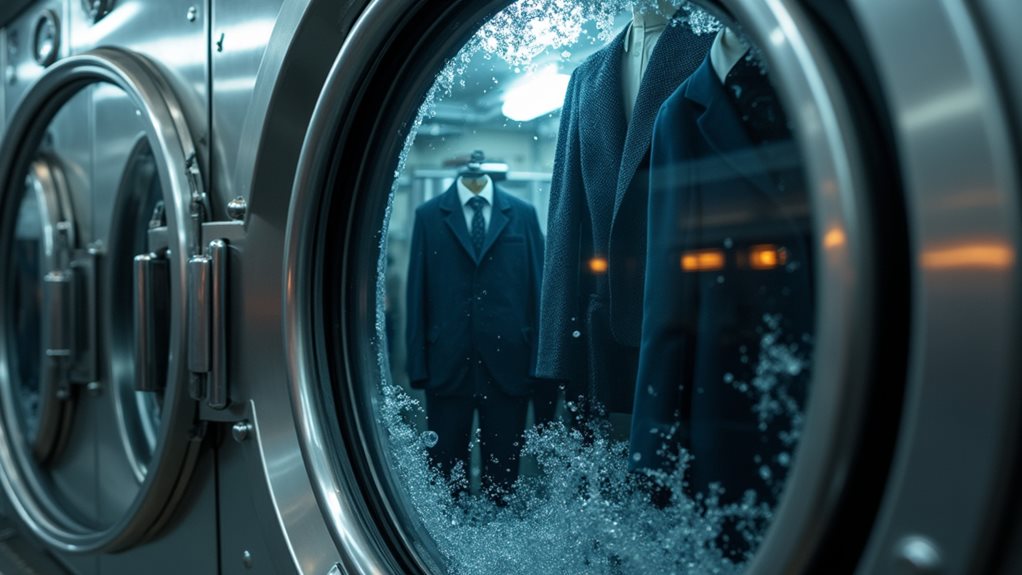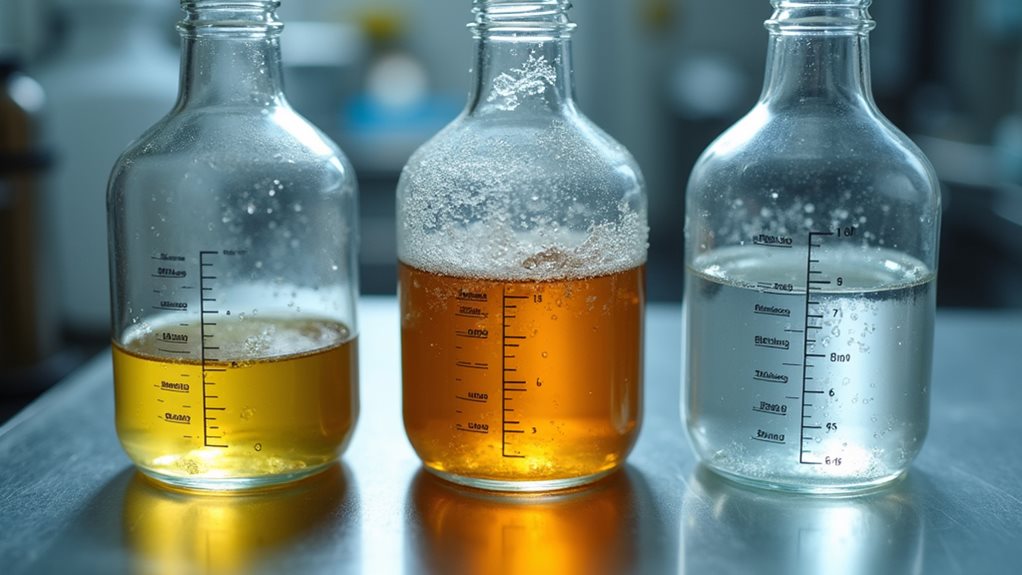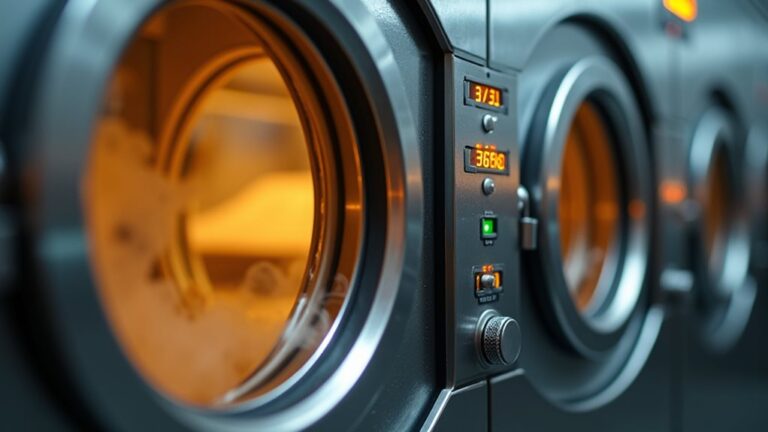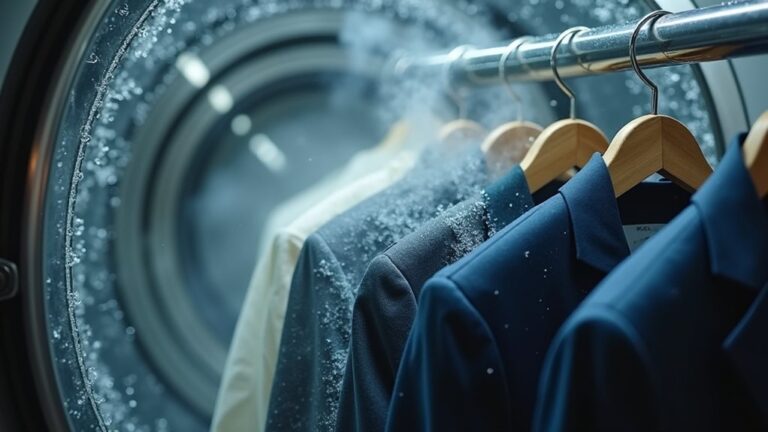Your clothes undergo a fascinating chemical bath when you drop them at the dry cleaner, where they’re first inspected and pre-treated for stubborn stains before entering a machine that looks like an oversized washing machine but uses solvents like perchloroethylene instead of water. These chemical solvents dissolve oils and grime without penetrating fabric fibers, then get recovered and reused while your garments are dried and pressed to perfection—and there’s so much more happening behind those curtains.
What Is Dry Cleaning and How Does It Work?
The mystery of dry cleaning used to baffle me completely – I’d drop off my favorite wool sweater and somehow it came back spotless without a single drop of water touching it, which seemed like pure magic until I learned the fascinating science behind it.
The dry cleaning process relies on chemical solvents, primarily perchloroethylene, instead of water to tackle delicate fabrics that would shrink or get damaged in your regular washing machine.
These solvents used in dry cleaning work brilliantly at removing stains and dirt without penetrating fabric fibers like water would.
Modern dry cleaning machines recover nearly all solvent for reuse, though the environmental impact has sparked interest in eco-friendly dry cleaning methods using alternative solvents like liquid carbon dioxide.
The process begins with garment inspection and pre-treatment of stains, followed by cleaning in specialized machines that dissolve oils and grime while preserving fabric integrity.
The Step-by-Step Dry Cleaning Process

Five distinct stages transform your wrinkled blazer from questionable to crisp, and I’ll walk you through each step so you can appreciate the careful choreography happening behind those mysterious curtains at your local cleaner.
First comes inspection and pre-treatment, where your delicate items get tagged, examined for damage, and receive targeted stain attention.
Your precious garments receive careful tagging, thorough damage assessment, and specialized stain treatment before entering the cleaning process.
Next, your garments enter the dry cleaning machine for the cleaning cycle, where specialized solvent in dry cleaning works its magic without water, gently agitating to lift stubborn dirt.
The drying and pressing stage follows, removing excess chemicals while preserving fabrics’ integrity.
Finally, the final inspection verifies removing tough stains succeeded, minimizing environmental impact through solvent recycling.
The dry cleaning machine resembles a large washing machine but uses chemical solvents like perchloroethylene or eco-friendly hydrocarbon alternatives instead of water to dissolve oils and greases.
This meticulous dry cleaning process protects your investment beautifully!
Types of Solvents Used in Professional Dry Cleaning

While you might assume all dry cleaning solvents work the same magic, the truth is that professional cleaners actually choose from several different chemical options, each with its own personality and cleaning superpowers.
Perchloroethylene (PERC) remains the heavyweight champion for effective stain removal, though it’s got some health baggage that makes me nervous.
Hydrocarbon solvents offer a gentler petroleum-based approach, while glycol ethers treat sensitive textiles like precious silk scarves.
The real game-changer? Liquid carbon dioxide cleaning—this eco-friendly alternative uses pressurized CO2 without toxic fumes 🌱.
Then there’s decamethylcyclopentasiloxane (try saying that three times fast!), which brings chemical-free properties to the table.
PERC’s dominance in the industry stems from its superior cleaning properties, non-flammability, and ability to be recycled within the cleaning process.
Each dry cleaning solvent impacts environmental considerations differently, so choosing wisely matters more than you’d think.
When to Choose Dry Cleaning Over Traditional Washing

Although your trusty washing machine handles most laundry with impressive efficiency, certain garments practically beg for the specialized attention that only professional dry cleaning can provide.
When you’re dealing with delicate fabrics like silk or wool, traditional washing becomes your enemy—I learned this the hard way after shrinking my favorite cashmere sweater 😅.
Oil-based stains, particularly stubborn ones like grease or makeup, require the specialized cleaning process that only professional dry cleaners can master.
Always check your care label first; if it screams “dry clean only,” listen to it!
That little care label isn’t making suggestions—it’s giving you a direct order to save your garment’s life!
Professional dry cleaners also provide expert pressing services that give your clothes a crisp, polished appearance that’s nearly impossible to achieve with home ironing.
This choice isn’t just about cleanliness—it’s about fabric preservation and guaranteeing your beloved garments maintain their shape, color, and integrity for years to come, preventing costly damage.
Care Tips for Maintaining Your Dry Cleaned Garments

Once your garments return from the dry cleaner, how you care for them at home determines whether they’ll maintain that crisp, professional appearance or gradually deteriorate into expensive disappointments.
I’ve learned (sometimes the hard way 😅) that protecting your clothes requires intentional steps, rather than tossing them in your closet and hoping for the best.
- Air out dry cleaned garments in a well-ventilated area to eliminate residual solvent odors before storage
- Use breathable garment bags or cotton covers to shield items from dust and moisture while maintaining airflow
- Store dry cleaned clothing in cool, dark spaces away from direct sunlight to prevent fading
- Promptly address stains by returning items immediately to your cleaner for professional treatment
- Allow dry cleaned items to rest between wears to preserve their shape and extend their lifespan
Remember that dry cleaning exists specifically for delicate fibers like silk, wool, and cashmere that would be damaged by water-based washing methods.




